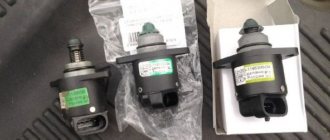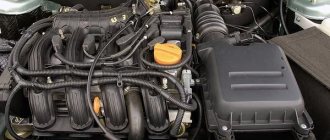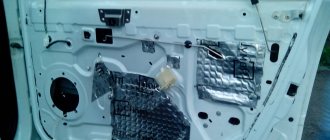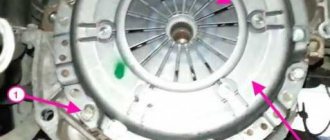Read more about do-it-yourself VAZ car repairs
The idea to eliminate floating speed on the Lada Lagrus belongs to Pavel Luzin
Why do the revs fluctuate on the Lada Largus?
According to reviews, the problem with floating engine speeds is familiar to many Lada Largus owners. This is especially true in winter, when the car has difficulty starting when cold (starting the engine is difficult in the morning). In such situations, floating speeds only make the situation worse. The tachometer needle may jump chaotically from 1000 to 1500 rpm or not reach the “warm-up” level at all, staying below the required idle speed values. Experts do not recommend self-diagnosis of the car. If the cause of the problem is unknown, it is better to contact a service station.
Return to contents
Car engine modifications and their features
The reasons why the speed may fluctuate on Largus are due to differences in the technical characteristics of the engines. Depending on the configuration, an 8- or 16-valve engine is installed.
Return to contents
8-valve K7M 800
This engine model was borrowed from Renault Logan and Sandero. Such motors have been installed on Largus since 2010. The unit complies with the Euro-4 standard, its power is 83 hp. With. Among the disadvantages:
- floating idle speed;
- lack of hydraulic compensators in the valve mechanism - the gaps need to be adjusted every 30,000 km;
- the need to replace the timing belt every 60,000 km - a broken belt will inevitably lead to bending of the valves;
- unreliability of crankshaft oil seals;
- vibration and increased noise during operation of the power unit.
high fuel consumption;
Installing an oxygen sensor on Lada Largus
Required materials and tools:
- Key to "22";
- Rags, flashlight to improve visibility;
- Diagnostic and control controllers.
Regulations:
- We install the machine above the inspection hole. We use a hydraulic lift if there is no hole;
- We turn off the engine, open the hood;
- We wait until the exhaust circuit cools down to a safe temperature so as not to damage the skin of the hands;
- From under the bottom we unclip the terminals on the diagnostic controller. We unscrew it, replace it with a new one, put on the block with wires;
- By analogy, we replace the control sensor.
DIY replacement completed. All that remains is to start the engine and check the functionality of the controllers. Subject to compliance with the regulations, subsequent maintenance after 80 thousand km.
Largus speed floats when cold
According to reviews, the problem with floating engine speeds is familiar to many Lada Largus owners. This is especially true in winter, when the car has difficulty starting when cold (starting the engine is difficult in the morning). In such situations, floating speeds only make the situation worse. The tachometer needle may jump chaotically from 1000 to 1500 rpm or not reach the “warm-up” level at all, staying below the required idle speed values. Experts do not recommend self-diagnosis of the car. If the cause of the problem is unknown, it is better to contact a service station.
How to eliminate floating idle speed on Lada Largus
One of the shortcomings that was noticed by owners of Lada Largus cars is floating speed after starting the engine in the morning. A long search for the cause of the unstable operation of the power unit led to the throttle assembly. It turns out that the whole problem lies in air leaks through the connections of the intake receiver and the remote control.
To troubleshoot the problem we will need:
- Ratchet heads for 6 and 8
- Torx key T-25
- Neutral sealant (odorless)
- FUM tape with a thickness of 0.075 mm, which is used by plumbers to seal threaded connections.
- Silicone Grease
- Clamp with screw tensioner 22x27 to strengthen the idle air channel hose
Instructions for eliminating floating speed on Lada Largus
- Now you need to remove the intake resonator and the intake air pipe
- Using a T-25 TORX socket or bit, unscrew the air filter housing. For convenience during dismantling, it is recommended to disconnect the vacuum booster hose from the intake manifold.
On the intake receiver we remove the wire and fasteners that go to the throttle assembly.Disconnect the idle air passage hose
Now you need to use a TORX key to unscrew the 2 screws with which the intake receiver is attached to the remote control and pull it a little to the side, since you will not be able to remove it due to the heater hoses.
- Now nothing interferes, you can unscrew the bolts securing the throttle assembly. For these purposes you will need a 8mm ratchet head.
- Removing the remote control
- The throttle assembly has rubber O-rings on both ends that must be removed.
- Now we move on to the plastic body of the intake receiver; the fitting also has a rubber seal that needs to be pulled out and coated with sealant. When the sealant has dried, we use a thin tie to outline the body of the elastic, avoiding any folds.
- Now you can assemble all the elements into one whole in reverse order.
To ensure that the throttle assembly fits well into the inlet and outlet pipes, lubricate the rubber seals with silicone. We also recommend using clamps to secure the idle air channel hose on both sides and the tube that goes to the vacuum booster, and thus prevent air leaks at the connections. The idea to eliminate floating speed on the Lada Lagrus car belongs to Pavel Luzin
Car engine modifications and their features
The reasons why the speed may fluctuate on Largus are due to differences in the technical characteristics of the engines. Depending on the configuration, an 8- or 16-valve engine is installed.
8-valve K7M 800
This engine model was borrowed from Renault Logan and Sandero. Such motors have been installed on Largus since 2010. The unit complies with the Euro-4 standard, its power is 83 hp. With. Among the disadvantages:
- floating idle speed;
- high fuel consumption;
- lack of hydraulic compensators in the valve mechanism - the gaps need to be adjusted every 30,000 km;
- the need to replace the timing belt every 60,000 km - a broken belt will inevitably lead to bending of the valves;
- unreliability of crankshaft oil seals;
- vibration and increased noise during operation of the power unit.
The 8-valve engine is too weak for Largus. Among the advantages are the unpretentiousness of the engine and its inexpensive maintenance.
16-valve K4M
This engine is used only in the top modifications of Largus in the “Lux” configuration. Engine power is 106 hp. s, but it still requires improvements. It differs from the previous unit:
- absence of vibration and almost complete absence of noise;
- low fuel consumption.
The disadvantage of the 16-valve engine can be considered its complex design, which leads to the high cost of the car. The engine life is about 450,000 km, but servicing the unit is more expensive. The main thing is not to use it often under increased loads and undergo maintenance on time.
Causes and methods of eliminating difficult engine starting
To successfully start the engine, the fuel mixture and a spark from the spark plugs must simultaneously appear in its cylinders.
The engine cannot be started if one or more elements are faulty. This happens, for example, when the starter does not spin the crankshaft.
If floating idle speeds have become too annoying, and it is no longer useful to turn the engine with the starter, it’s time to understand the causes of the malfunctions that have arisen. The table shows the most common reasons why the Lada Largus engine speed fluctuates and it may not start.
Remedy
Regular and timely maintenance of the car will minimize or completely eliminate possible problems with starting the Lada Largus engine.
You should not randomly change all the parts without first checking their functionality. Comprehensive diagnostics are necessary, since there can be several sources of malfunction at once. Modern cars of the VAZ family are equipped with the same type of engines. For this reason, the solution to the problem will be virtually the same for different cars.
Air leaks as a cause of floating speed
Many owners note that in the mornings, especially in winter, the engine is unstable after starting, the speed jumps, and the car begins to twitch while driving. They look for a problem in the immobilizer or spark plugs, but if the diagnostics do not reveal any problems, the problem is in the throttle assembly.
The malfunction consists of air leaking through a loose connection between the throttle assembly and the intake receiver. The problem is solved either by replacing the sealing ring with a similar new one, or by modifying the design using plumbing tape. Procedure for replacing the ring:
- the throttle valve drive cable is disconnected;
- remove the rubber band that secures the intake pipe;
- the plastic “muffler” of the intake is removed;
- the power plug is disconnected from the IAC and throttle position sensor;
- the air filter mounting bolts are unscrewed;
- the throttle assembly mounting bolts are unscrewed;
- The old ring is removed and a new one is put on.
Next, everything is assembled in reverse order and tested for functionality.
The process of replacing the throttle assembly O-ring takes a maximum of half an hour.
Although the engines were borrowed from popular Renault models, they migrated under the hood of the VAZ Largus along with common faults. However, the problem with floating idle speed can be eliminated on your own. If you lack confidence and experience, it is better to contact a service station.
Hello guys. Many (if not all) largus breeders sooner or later encounter a certain problem. And this problem is nothing more than floating speed on a cold engine. Naturally, this problem did not bypass me either, although it did not manifest itself immediately, but gradually. The first winter went well. The second, sometimes the speed began to drizzle, but only in severe frost. By the third winter, the speed was already floating with all its might even at zero degrees. Well, finally I got tired of it and started to stress me out. As you know, the rubber seal on the throttle valve is to blame. Even two))) At first I wanted to replace these rubber bands, but the price is from 300 to 700 rubles. for a piece somehow stopped me. As a result, it was decided to wind the fum tape for 15 rubles. This is where the real savings are! Well, by tradition, I’ll briefly describe the process, even though it’s already been done a hundred thousand times on these Internets of yours. To begin with, I still drove the car into the garage, because... It's not May outside.
I will not describe the process of removing the damper itself. There are tons of manuals on this topic on the Internet, although they only take 5 minutes)))
Now you can remove the seals and wipe their seat to keep it clean. By the way, at this stage you can just understand where exactly the air was siphoning. There will be traces of dirt in these places.
The revs began to fluctuate a little when cold, and they stayed for a long time at 1300 rpm when warming up; in general, Largus’s favorite problem with the K4M began to appear.
This is my second Largus, on the first I wound up the fum tape, then under warranty they changed the receiver, installed a new one with the inscription RENAULT, but the rings are of course a weak point. So, the known methods of treatment 1.) Rewind the fum tape, not reliably, not for long, the fum tape practically does not absorb shock, as a result, the ring presses its place in it and the suction appears again. 2.) Put a new ring with a code 8200068566
, good but expensive, the toad is against it and there is a chance that the ring will last for a year.
3.) Put on a Nisanov ring with code 16618-00QAA
, this is the same new ring only with a different code and a lower price, but still the toad is against it.
4.) Install the Gostov ring GOST 18829-73/9833-73 064-072-46
, cheap, reliable and cheerful, but mother is lazy, you need to look for such rings. 5.) There were Gost rings available, but not 4.6 but 6 mm, so I decided to make myself an eternal ring from it, because... the ring is thicker, the throttle with such a ring doesn’t fit into the receiver, so I’m redoing it a little. I just file off the excess rubber and it becomes a little flat. We assemble this device from a canister cap, a bolt with a nut and two washers, a drill and a file clamped in a vice.
it turns out to be cut something like this
On the left is mine, on the right is factory
I also sharpened the inner plane a little.
The throttle, of course, has an untreated casting; the bracek removed it with a knife
I put my ring on and it turned out something like this
The throttle is now inserted into the receiver with very noticeable force, + the contact area of the ring with both the throttle and the receiver has increased, so I hope it will last a long time.
PS The next day I came to the garage, started the car and... the revs were too high, almost the same as it was, Sadness. Well, apparently the machine is just as vindictive as I am, we’ll treat it. Apparently I remembered and got used to driving with air leaks. In the evening I put it in the garage and remove the terminal from the battery, the next morning I put the terminal on and try to persuade the controller to relearn. Persuasion is carried out according to the following algorithm:
1.) Disconnect the battery for 15-20 minutes (I disconnected it at night) 2.) Connect the battery. 3.) Turn on the ignition but do not start the engine, wait until the lights go out for another 10-15 seconds 4.) Turn off the ignition. 5.) Repeat points 3.) and 4.) three to five times. 6.) Turn on the ignition and start the engine.
I have known this algorithm since the time of 21114, although point 5.) was not in it. Just in case, I did it too. The algorithm reminded renby in the note Idle air control - IAC
Elimination of floating engine speed of Lada Largus
The revs began to fluctuate a little when cold, and they stayed for a long time at 1300 rpm when warming up; in general, Largus’s favorite problem with the K4M began to appear.
This is my second Largus, on the first I wound up the fum tape, then under warranty they changed the receiver, installed a new one with the inscription RENAULT, but the rings are of course a weak point. So, the known methods of treatment 1.) Rewind the fum tape, not reliably, not for long, the fum tape practically does not absorb shock, as a result, the ring presses its place in it and the suction appears again. 2.) Put in a new ring with code 8200068566 , it’s good but expensive, I don’t mind and there’s a chance that the ring will last for a year. 3.) Put on a Nisanov ring with code 16618-00QAA , this is the same new ring only with a different code and a lower price, but still the toad is against it. 4.) Install the Gostov ring GOST 18829-73/9833-73 064-072-46 , cheap, reliable and cheerful, but mother is lazy, you need to look for such rings. 5.) There were Gost rings available, but not 4.6 but 6 mm, so I decided to make myself an eternal ring from it, because... the ring is thicker, the throttle with such a ring doesn’t fit into the receiver, so I’m redoing it a little. I just file off the excess rubber and it becomes a little flat. We assemble this device from a canister cap, a bolt with a nut and two washers, a drill and a file clamped in a vice.
It turns out to grind something like this.
On the left is mine, on the right is factory.
I also sharpened the inner plane a little.
The throttle, of course, has an untreated casting; the bracek removed this with a knife.
I put my ring on and it turned out something like this.
The throttle is now inserted into the receiver with very noticeable force, + the contact area of the ring with both the throttle and the receiver has increased, so I hope it will last a long time.
PS The next day I came to the garage, started the car and... the revs were too high, almost the same as it was, Sadness. Well, apparently the machine is just as vindictive as I am, we’ll treat it. Apparently I remembered and got used to driving with air leaks. In the evening I put it in the garage and remove the terminal from the battery, the next morning I put the terminal on and try to persuade the controller to relearn. Persuasion is carried out according to the following algorithm:
1.) Disconnect the battery for 15-20 minutes (I disconnected it at night) 2.) Connect the battery. 3.) Turn on the ignition but do not start the engine, wait until the lights go out for another 10-15 seconds 4.) Turn off the ignition. 5.) Repeat points 3.) and 4.) three to five times. 6.) Turn on the ignition and start the engine.
I have known this algorithm since the time of 21114, although point 5.) was not in it. Just in case, I did it too.
By the way, this must be done if any sensor has been changed or touched/moved, unscrewed/tightened. The controller re-interrogates all sensors and remembers their zero values, i.e. retrained.
As a result, I started it, a few seconds and the speed dropped to 900-950 rpm, while I closed the garage it sat down, the speed was 750-800 rpm, I drove 3 km to work, the average consumption from 9.3 l/100 dropped to 9.2 l/100, day the car sat for a while, started it in the evening (it’s cool and raining outside), the speed during warm-up again drops to 900 rpm in 10-15 seconds, so far everything is fine, ttt. We'll look further.
By the way, don’t forget to find the code for the radio (written on the warranty card), the radio also forgets everything.











